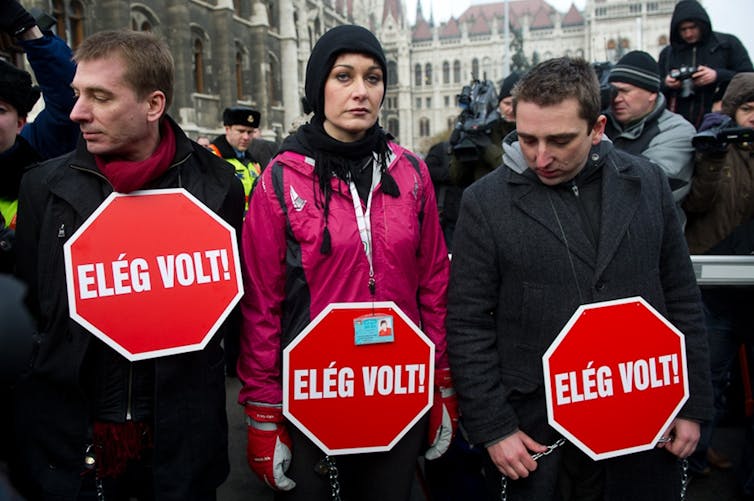Hungarian leader and strongman Viktor Orbán, who presided over the radical decline of democracy in his country, is scheduled to meet with former President Donald Trump, now the presumptive GOP presidential nominee, at Trump’s Mar-a-Lago resort on March 8, 2024.
Orbán has been Hungary’s prime minister since 2010. Under his leadership, the country became the first nondemocracy in the European Union – an “illiberal state,” as Orbán proudly declared. Trump expressed his admiration for Orbán and his authoritarian moves during their meeting at the White House in 2019.
“You’re respected all over Europe. Probably, like me, a little bit controversial, but that’s OK,” Trump said. “You’ve done a good job and you’ve kept your country safe.”
I’ve followed their mutual romance with illiberalism for a long time. Although I am now in the U.S. as an academic, I was elected to the Hungarian Parliament in 2010 when Orbán’s rule started.
As the U.S. braces for a potential second Trump presidency, Americans may rightly wonder: Would Trump’s America mirror Orbán’s Hungary in its slide toward authoritarianism?

Authoritarianism from within
I can still feel the pleasant spring breeze on my skin as I walked up the National Assembly’s stairs in my freshly bought suit. As newly elected members of Parliament, my Green Party colleagues and I stepped into our roles with high hopes and detailed plans to fix Hungary’s ailing economy and move toward sustainability.
I also remember the cold winter day a year and half later when we chained ourselves to the parliament building. It was a demonstration against the hollowing of parliamentary work and democratic backsliding under Orbán’s rule.
If the parliament is the political home of democracy, Hungary’s was vacant by 2012.
Orbán and his party in power hijacked democratic institutions. The nationwide right-wing media network is a crucial component of this authoritarian power. As the Voice of America reported in 2022, Orbán’s allies “have created a pervasive conservative media ecosystem that dominates the airwaves and generally echoes the positions of the Orbán government.”
His government gerrymandered local districts and allowed voters to register outside their home districts, both aimed at favoring Orbán and his party. The government also staffed the public prosecutor’s office with loyalists, ensuring that any misconduct by those in power stays hidden.
Republicans in the U.S. have followed a similar trajectory with their support of Trump as his rhetoric grows more authoritarian. Trump says if he wins the election, he wants to be “a dictator” for one day. A recent poll shows that 74% of Republicans surveyed said it would be a good idea for Trump to “be a dictator only on the first day of his second term.”
Orbán has spent years undermining the independence of Hungary’s judiciary, ensuring its rulings are friendly to his government and allies. While still an independent institution, the U.S. Supreme Court – with three Trump-nominated justices – has become a pillar of Trumpism, handing down rulings overturning the constitutional right to abortion and limiting civil rights.
Fox, OANN, and other right-wing media ensure that large parts of America see the world through a Trumpian lens.
Authoritarian populists tilt the democratic playing field to favor themselves and their personal and political interests. Subverting democracy from the inside without violent repression allows leaders like Orbán and Trump to pretend they are democratic. This authoritarianism from within creates chokepoints, where the opposition isn’t crushed, but it has a hard time breathing.

No democracy with division
How can strongmen get away with these antidemocratic politics? If there is one lesson from Hungary, it is this: Democracy is not sustainable in a divided society where many are left behind economically.
The real power of authoritarian populists like Trump and Orban lies not in the institutions they hijack but in the novel electoral support coalition they create.
They bring together two types of supporters. Some hardcore, authoritarian-right voters are motivated by bigotry and hatred rooted in their fear of globalization’s cultural threats. However, the most successful right-wing populist forces integrate an outer layer of primarily working-class voters hurt by globalization’s economic threats.
Throughout the 20th century, Democrats in the U.S. and left-of-center parties in Europe provided a political home for those fearing economic insecurity. This fostered a political system that engendered equality and a healthy social fabric, giving people reason to care for liberal democratic institutions.
However, when the economy fails to deliver, disillusionment with capitalism morphs into an apathy toward liberal democracy.
If the liberal center appears uncaring, authoritarian populists can mobilize voters against both the cultural and economic threats posed by globalization.
In Hungary, the first signs of authoritarianism appeared in economically left-behind rural areas and provincial small and medium towns well before Orbán’s 2010 victory. While these provincial towns suffered from increasing mortality, deindustrialization and income loss, the parties of the liberal center continued to sing hymns about the benefits of globalization, detached from the everyday experience of economic insecurity.
As I showed in my book, neglecting this suffering was the democratic center’s politically lethal failure.
By today, Hungary’s liberal and left-of-center parties have retreated to the biggest cities, leaving their former provincial political strongholds up for grabs for the radical right. The same is taking place in the U.S., with the Republicans becoming a party of the working class and nonmetropolitan America.
The success of authoritarian populism in Hungary might seem disheartening. However, there is a silver lining: Those committed to democracy in the U.S. still have time to learn from Hungary’s mistakes.

